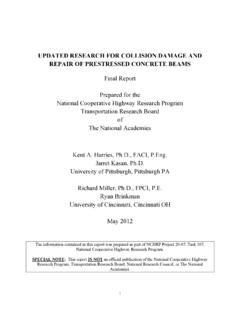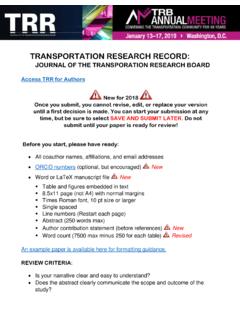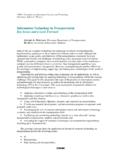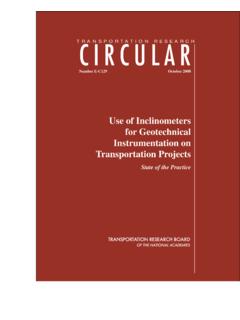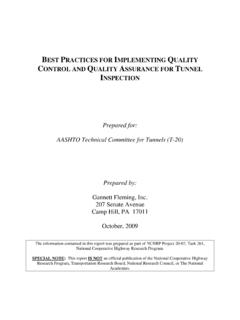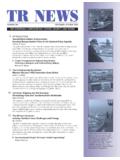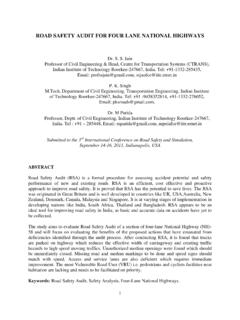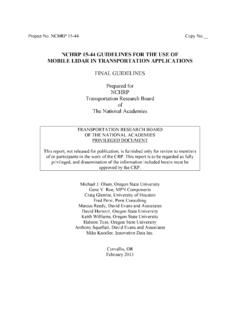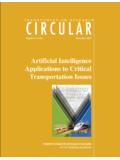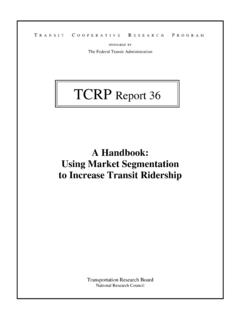Transcription of PART 3 RAIL TRANSIT CAPACITY CONTENTS
1 7 UDQVLW &DSDFLW\ DQG 4 XDOLW\ RI 6 HUYLFH 0 DQXDO. PART 3. rail TRANSIT CAPACITY . CONTENTS . 1. rail CAPACITY BASICS .. 3-1. 3-1. Grouping .. 3-1. The 3-2. Design versus Achievable CAPACITY .. 3-3. Service 3-4. Line CAPACITY .. 3-5. Train Control Throughput .. 3-5. Commuter rail Throughput .. 3-6. Station Dwells .. 3-6. Train/Car 3-7. 3-7. Car 3-7. Train 3-7. Station Constraints .. 3-8. 2. TRAIN CONTROL AND 3-9. 3-9. Fixed-Block 3-9. Cab Signaling .. 3-10. Moving-Block Signaling Systems .. 3-10. Safety 3-11. Hybrid Systems .. 3-11. Automatic Train Operation .. 3-11. Automatic Train Supervision .. 3-12. Fixed-Block Throughput .. 3-12. Station Close-In Time .. 3-12. Moving-Block Throughput .. 3-16.
2 Turn-Back 3-18. Junction Throughput .. 3-19. Summary .. 3-21. 3. STATION DWELL TIMES .. 3-23. 3-23. Dwell Time 3-23. Doorway Flow Rates .. 3-25. Estimating Dwell Times .. 3-27. 4. PASSENGER LOADING LEVELS .. 3-29. 3-29. Loading 3-29. Space Requirements .. 3-30. Vehicle Specific Calculations .. 3-31. Default Method .. 3-33. Length .. 3-33. Loading 3-35. Part 3/ rail TRANSIT CAPACITY Page 3-i CONTENTS 7 UDQVLW &DSDFLW\ DQG 4 XDOLW\ RI 6 HUYLFH 0 DQXDO. 5. OPERATING ISSUES .. 3-39. Introduction .. 3-39. Operating 3-39. Estimating Margins .. 3-43. Skip-Stop 3-43. Passenger-Actuated Doors .. 3-44. Other Station Constraints .. 3-44. Wheelchair 3-45. 6. GRADE-SEPARATED SYSTEMS 3-47. Introduction .. 3-47.
3 The Weakest Link .. 3-47. Growth and Achievable 3-48. Simple Procedure .. 3-48. Complete Procedure .. 3-52. 7. LIGHT rail 3-63. Introduction .. 3-63. Selecting the Weakest Link .. 3-63. Other CAPACITY 3-63. Single Track .. 3-64. Calculating Single-Track Headway Restrictions .. 3-64. Signaled Sections .. 3-66. On-street Operation .. 3-66. Determining On-Street CAPACITY .. 3-67. Right-of-Way with Grade Crossings .. 3-68. Signal Pre-emption .. 3-68. Grade Crossings and Station Dwell Times .. 3-68. Train Length and Station 3-69. Street Block 3-69. Station Limitations .. 3-69. Wheelchair Accessibility 3-70. Introduction .. 3-70. High Platforms .. 3-71. Low-Floor Cars .. 3-73. CAPACITY Determination 3-74.
4 8. COMMUTER rail CAPACITY .. 3-77. Introduction .. 3-77. Train Throughput .. 3-77. Station Constraints .. 3-78. Station Dwells .. 3-79. Train 3-80. 9. AUTOMATED GUIDEWAY TRANSIT CAPACITY .. 3-83. Introduction .. 3-83. Train Control 3-83. Passenger Flow Rates and Dwells .. 3-85. Loading 3-85. Off-Line 3-86. 10. REFERENCES .. 3-87. Part 3/ rail TRANSIT CAPACITY Page 3-ii CONTENTS 7 UDQVLW &DSDFLW\ DQG 4 XDOLW\ RI 6 HUYLFH 0 DQXDO. 11. EXAMPLE PROBLEMS .. 3-89. APPENDIX A. EXHIBITS IN CUSTOMARY UNITS .. 3-101. LIST OF EXHIBITS. Exhibit 3-1 Line CAPACITY Flowchart .. 3-5. Exhibit 3-2 Average rail TRANSIT Headway Components in Seconds .. 3-6. Exhibit 3-3 Train CAPACITY Flow Chart .. 3-7. Exhibit 3-4 Distance-Time Plot of Two Consecutive Trains (acceleration and braking curves omitted for clarity).
5 3-13. Exhibit 3-5 Station Headway for Lines at CAPACITY .. 3-14. Exhibit 3-6 Speed Limits on Curves and 3-14. Exhibit 3-7 Distance-Speed 3-15. Exhibit 3-8 Effect of Grade on Station 3-15. Exhibit 3-9 Headway Changes with 3-16. Exhibit 3-10 Moving Block Headways with 45-Second Dwell and 20-Second Operating Margin Compared with Conventional Fixed Block 3-17. Exhibit 3-11 Terminal Station Track Layout .. 3-18. Exhibit 3-12 Flat Junction Track 3-20. Exhibit 3-13 Headway Result Summary in Seconds with 200-m (660-ft) train .. 3-21. Exhibit 3-14 Headway Components for Cab Control Signaling with a 120-Second 3-21. Exhibit 3-15 Dwell Time Components of Four rail TRANSIT Stations .. 3-24. Exhibit 3-16 Selection of rail TRANSIT Door Flow 3-25.
6 Exhibit 3-17 Summary of rail TRANSIT Average Door Flow 3-26. Exhibit 3-18 BC TRANSIT SkyTrain Door Flow Rate Comparisons .. 3-26. Exhibit 3-19 Quadruple-Stream Doorways .. 3-27. Exhibit 3-20 Controlling Dwell Data Limits (seconds).. 3-28. Exhibit 3-21 Passenger Space on Selected North American Heavy rail Systems .. 3-29. Exhibit 3-22 Male Passenger Space Requirements .. 3-30. Exhibit 3-23 Schematic LRT Car Showing Dimensions .. 3-33. Exhibit 3-24 Linear Passenger Loading Articulated LRVs .. 3-33. Exhibit 3-25 Linear Passenger Loading Heavy rail Cars .. 3-34. Exhibit 3-26 Summary of Linear Passenger Loading (p/m) .. 3-34. Exhibit 3-27 Peak Hour Passenger Distribution Between Cars of Trains .. 3-35.
7 Exhibit 3-28 Individual Train Loads, TTC Yonge Subway, Wellesley Southbound (Jan. 11, 1995) .. 3-36. Exhibit 3-29 Individual Train Loads, Vancouver, SkyTrain Broadway Station Inbound (October 27, 1994, 50 trains, 6,932 passengers in Data Set) .. 3-36. Exhibit 3-30 Diversity of Peak Hour and Peak 15 Minutes .. 3-37. Exhibit 3-31 Observed rail Headways and Dwell Times .. 3-40. Exhibit 3-32 Dwell and Headway Data Summary of Surveyed North American Heavy rail TRANSIT Lines Operating at or Close To CAPACITY (1995).. 3-41. Exhibit 3-33 Headway Components of Surveyed North American Heavy rail TRANSIT Lines At or Close to CAPACITY (seconds) .. 3-42. Exhibit 3-34 Relationship Between Operating Margin and the Headway Coefficient of Variation.
8 3-43. Exhibit 3-35 Wheelchair Loading Platform and Ramp .. 3-45. Part 3/ rail TRANSIT CAPACITY Page 3-iii CONTENTS 7 UDQVLW &DSDFLW\ DQG 4 XDOLW\ RI 6 HUYLFH 0 DQXDO. Exhibit 3-36 Profiled Light rail Platform Providing For One Wheelchair-Accessible Door .. 3-46. Exhibit 3-37 Profiled Light rail Platform with Slide-Out or Fold-Down Step .. 3-46. Exhibit 3-38 Grade-Separated rail TRANSIT Performance Assumptions Simple Method CAPACITY Calculation .. 3-49. Exhibit 3-39 Cab Control Throughput .. 3-50. Exhibit 3-40 Moving-Block (Variable Safety Distance) 3-50. Exhibit 3-41 Achievable CAPACITY with Multiple Command Cab-Control Signaling System .. 3-51. Exhibit 3-42 Achievable CAPACITY With Moving-Block Signaling 3-52.
9 Exhibit 3-43 Minimum Train Separation 3-54. Exhibit 3-44 Minimum Train Separation versus Length .. 3-55. Exhibit 3-45 Distance Speed Braking Into a Station .. 3-56. Exhibit 3-46 1995 Peak-Period Station Dwell Times for Heavily Used Systems (seconds).. 3-58. Exhibit 3-47 Passengers per Unit Train Length, Major North American rail Trunks, 15- Minute Peak .. 3-60. Exhibit 3-48 Diversity of Peak Hour and Peak 15-Minute 3-61. Exhibit 3-49 Typical Maximum Passenger Capacities of Grade-Separated rail TRANSIT . Excluding All-Seated Commuter rail .. 3-62. Exhibit 3-50 Data Values for Single Track LRT Travel Time .. 3-65. Exhibit 3-51 Light rail Travel Time Over Single Track 3-65. Exhibit 3-52 Light rail Platform Options at a 3-68.
10 Exhibit 3-53 Light rail Single Track Terminus with Separate Unloading Platform (Baltimore) .. 3-70. Exhibit 3-54 Wheelchair Access 3-71. Exhibit 3-55 Recommended Loading Level Range for Light rail Vehicles in Simple CAPACITY Calculation .. 3-75. Exhibit 3-56 Light rail CAPACITY on Segregated Right-of-Way With Maximum Cab- Control Signaling .. 3-75. Exhibit 3-57 Commuter rail Car 3-81. Exhibit 3-58 AGT Minimum Train Separation Times .. 3-83. Exhibit 3-59 AGT Train Separation versus 3-84. Exhibit 3-60 Suggested AGT Separation Calculation Default Values .. 3-84. Exhibit 3-61 Orlando Airport People-Mover Doorways .. 3-85. Part 3/ rail TRANSIT CAPACITY Page 3-iv CONTENTS 7 UDQVLW &DSDFLW\ DQG 4 XDOLW\ RI 6 HUYLFH 0 DQXDO.
